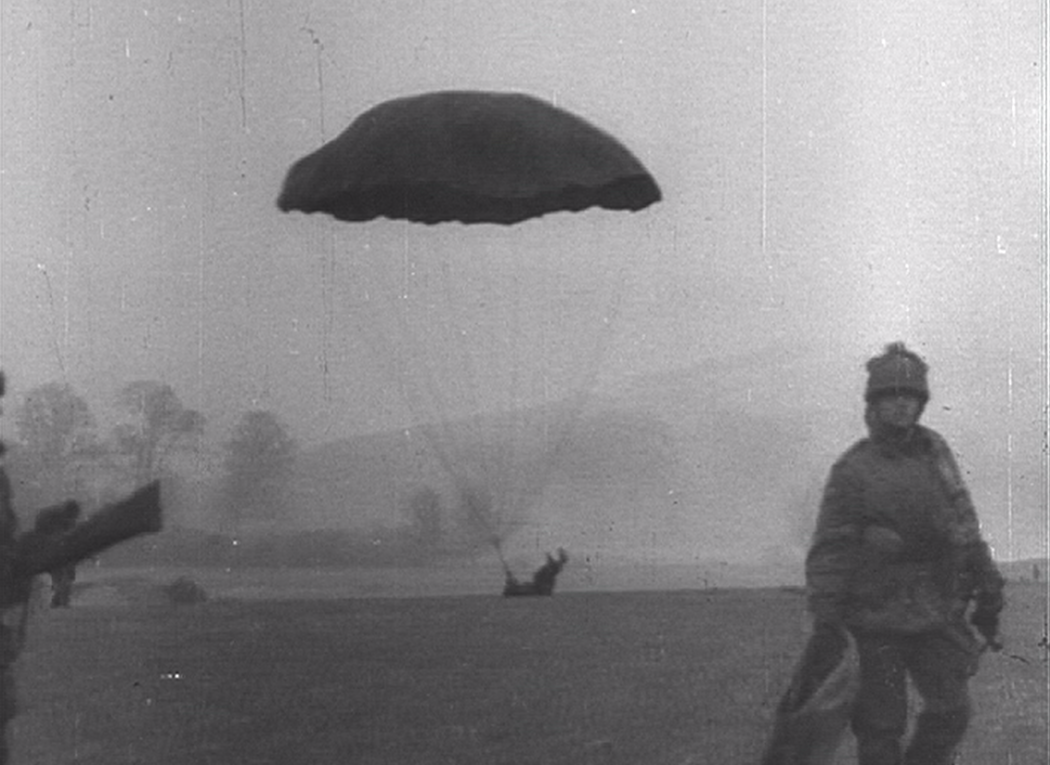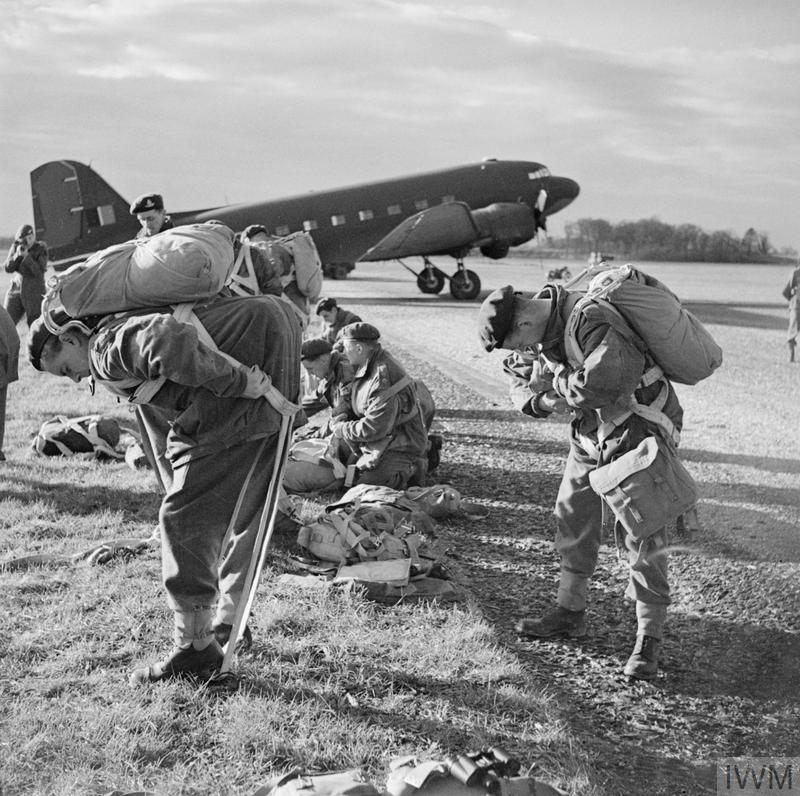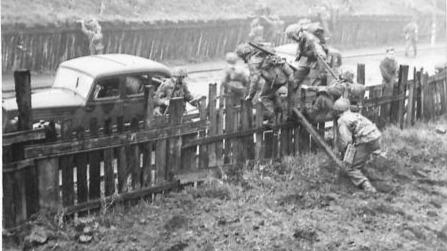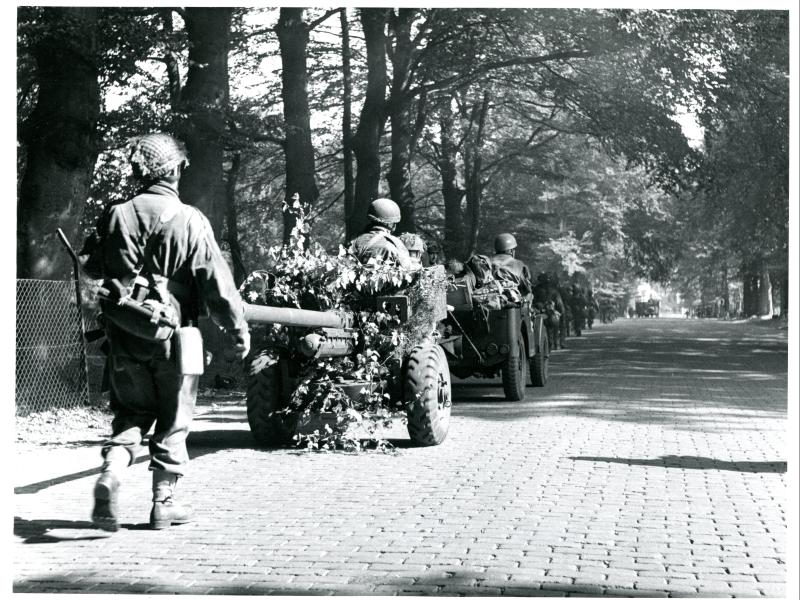1st Airborne Battle Training

The British 1st Airborne Division deployed to North Africa in November 1942 and saw action in Algeria, Tunisia, Sicily and Italy before returning to the UK in December 1943. Its home would be in Lincolnshire and the East Midlands.
After a period of recovery, the Division’s personnel concentrated on training for their next deployment. The intensive training period would last until the Allied assault on mainland Europe in June 1944, after which the Division would be on stand-by as a reserve force for immediate deployment.
Parachute and Glider Training

A jeep is loaded aboard a Horsa glider in southern England during Exercise MUSH, 22 April 1944. (IWM H 37692)
Men of the 1st and 4th Parachute Brigades were sent for refresher parachute training at Stoney Cross airfield in Hampshire and No 1 Parachute Training School at Ringway (now Manchester Airport). This was particularly important for the 4th Parachute Brigade, whose personnel had been trained in India and the Middle East, where the latest training techniques, equipment and aircraft were not available. Continuation training was carried out from local East Midlands airfields using US C-47 troop carrier aircraft.
Even without a real enemy to contend with, the act of parachuting itself could be extremely hazardous and fatal casualties were suffered. On 8 April 1944, during Exercise DOROTHY, Private Robert Hales of the 11th Parachute Battalion took off from RAF Saltby in a C-47 of the US 314th Troop Carrier Group. He was seventh to jump in his stick of paratroopers. His parachute became snagged on the C-47 aircraft. Despite feverish attempts to free his parachute from the aircraft, it was firmly attached. It was decided that the safest course of action was to alert the Air-Sea Rescue service and then cut Private Hales’ parachute free when the aircraft was flying low over the sea and close to rescue craft. Tragically, despite extensive searching, no trace was ever found of Private Hales after he fell from the aircraft. He is commemorated at the Brookwood 1939-1945 Memorial in Surrey.
At Barkston Heath airfield on 11 July 1944, Trooper William Rew of the 1st Airborne Reconnaissance Squadron was taking part in a practice jump when he slipped as he exited the aircraft. The large bag containing his Bren light machine-gun became entangled with his parachute’s static line and this prevented his parachute from opening. Trooper William Brown Rew rests in the St Ninian's Parish Burial Ground, Bannockburn.
On 14 July 1944, 2nd Lieutenant Arthur Bradshaw of the 1st Airborne Divisional Signals was killed in a parachuting accident at the US Airborne Pathfinder School at North Witham airfield. He had only been with his unit since April 1944 and was carrying out a jump with Polish Pathfinder paratroopers. It was the first time that he had used an American parachute rather than a British one. The subsequent Court of Inquiry concluded that the parachute had not been hooked up properly to the aircraft, probably because 2nd Lieutenant Bradshaw had no previous experience with this type of parachute. 2nd Lieutenant Arthur Balfour Bradshaw rests in Lisburn Cemetery.
During a training jump at Ropsley Heath on 21 July 1944, Driver John Beal of the Royal Army Service Corps was killed after his parachute canopy was hit and collapsed by a falling supply container; he rests in Yorktown (St Michael) Churchyard, Surrey.

A jeep is loaded aboard a Horsa glider in southern England during Exercise MUSH, 22 April 1944. (IWM H 37692)
Men of the 1st Airlanding Brigade took part in glider training exercises, often flying from airfields in southern England where their British Horsa gliders and pilots were based. Their training could be hazardous, like parachuting, but more people could be involved if things went wrong. On 4 April 1944, a Horsa glider was being towed by a Short Stirling Mk IV of No 196 Squadron as part of Exercise DREME. They had taken off from RAF Keevil in Wiltshire, and the plan was to release the glider over RAF Brize Norton, Oxfordshire. The cloud base was very low, and the Stirling hit a tree at Warnford in Hampshire. The glider separated from the Stirling and crashed immediately; the Stirling struggled on but eventually crashed close to Romsey in Hampshire. All aboard the Horsa were killed: two pilots from the Glider Pilot Regiment and 25 members of No 3 Platoon 'A' Company, 7th (Airborne) Battalion, The King's Own Scottish Borderers, based in Woodhall Spa, Lincolnshire. The six airmen on board the Stirling were also killed.
Battle Training

Airborne troops in a tactical exercise practising fighting in a built-up area. Such training would prove particularly useful during fighting in Arnhem in September 1944. (IWM H 33921)
Tactical drills were practised at various unit levels, and included such techniques as general battle drills, street-fighting, reorganization after night landings, night attacks, and setting up defensive positions.
Infantry platoons (around 35 men) and companies (around 120 men) ran their own training programmes for individual weapon handling, camouflage and concealment, fire and manoeuvre, and physical fitness. Long-distance route marches were a favoured training aid: Airborne platoons were required to cover 50 miles (80km) in 24 hours, and battalions 32 miles (51km).
There were also Brigade-level exercises (2,000-2,500 men) and one major formal exercise for the whole Division (around 12,100 men) in May 1944 - Exercise RAGS – which took place in East and North Yorkshire.
In addition to training involving physical activities, troops also attended talks on such topics as the course of the war, escape and evasion, and the latest German organization and tactics. For familiarization purposes, exchanges visits were organized between units of the British 1st Airborne Division, US 82nd Airborne Division and US IX Troop Carrier Command.
EXERCISES & ROUTE MARCHES
For more information on Airborne exercises and route marches in South Kesteven, please follow the links below:

